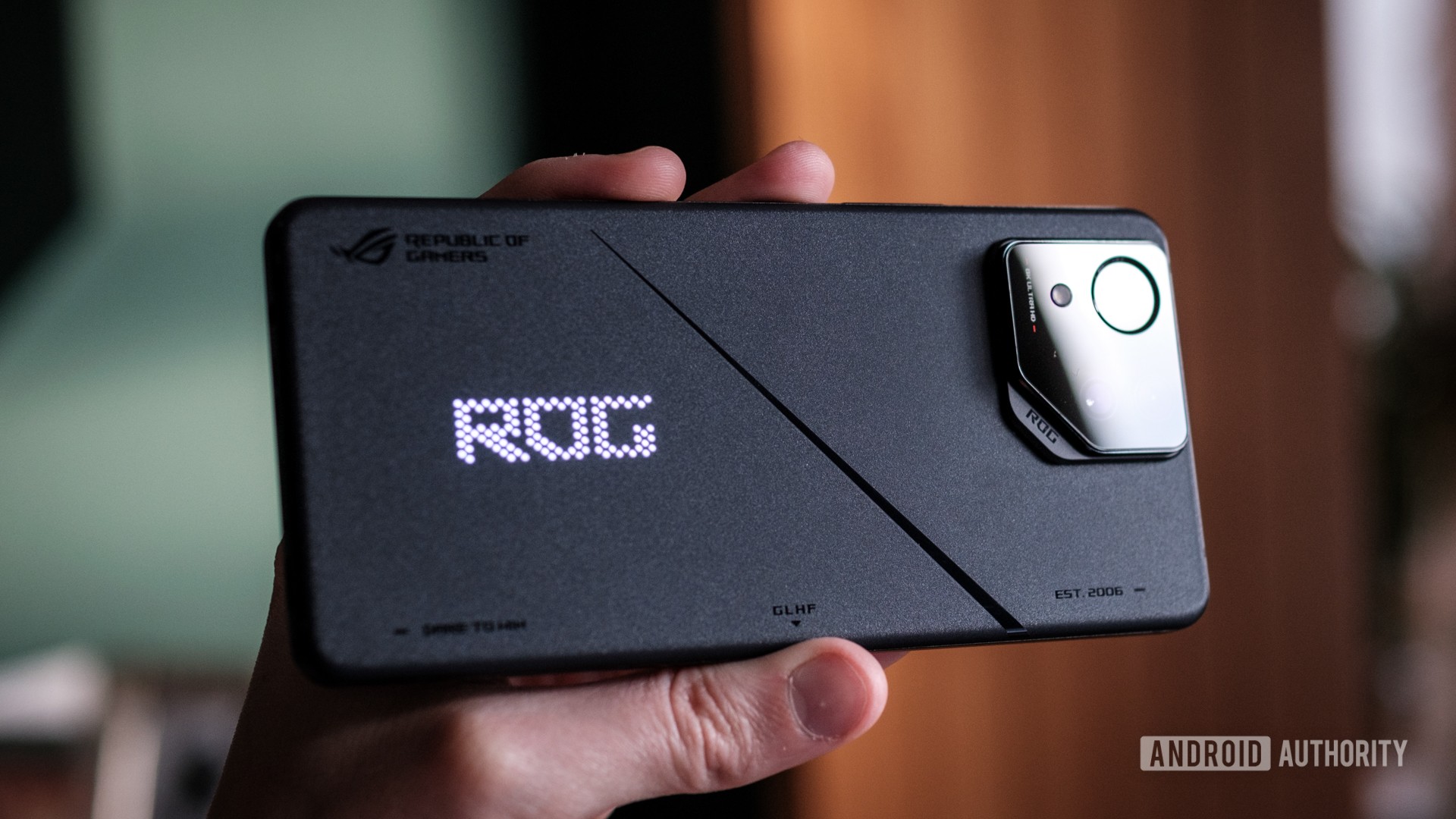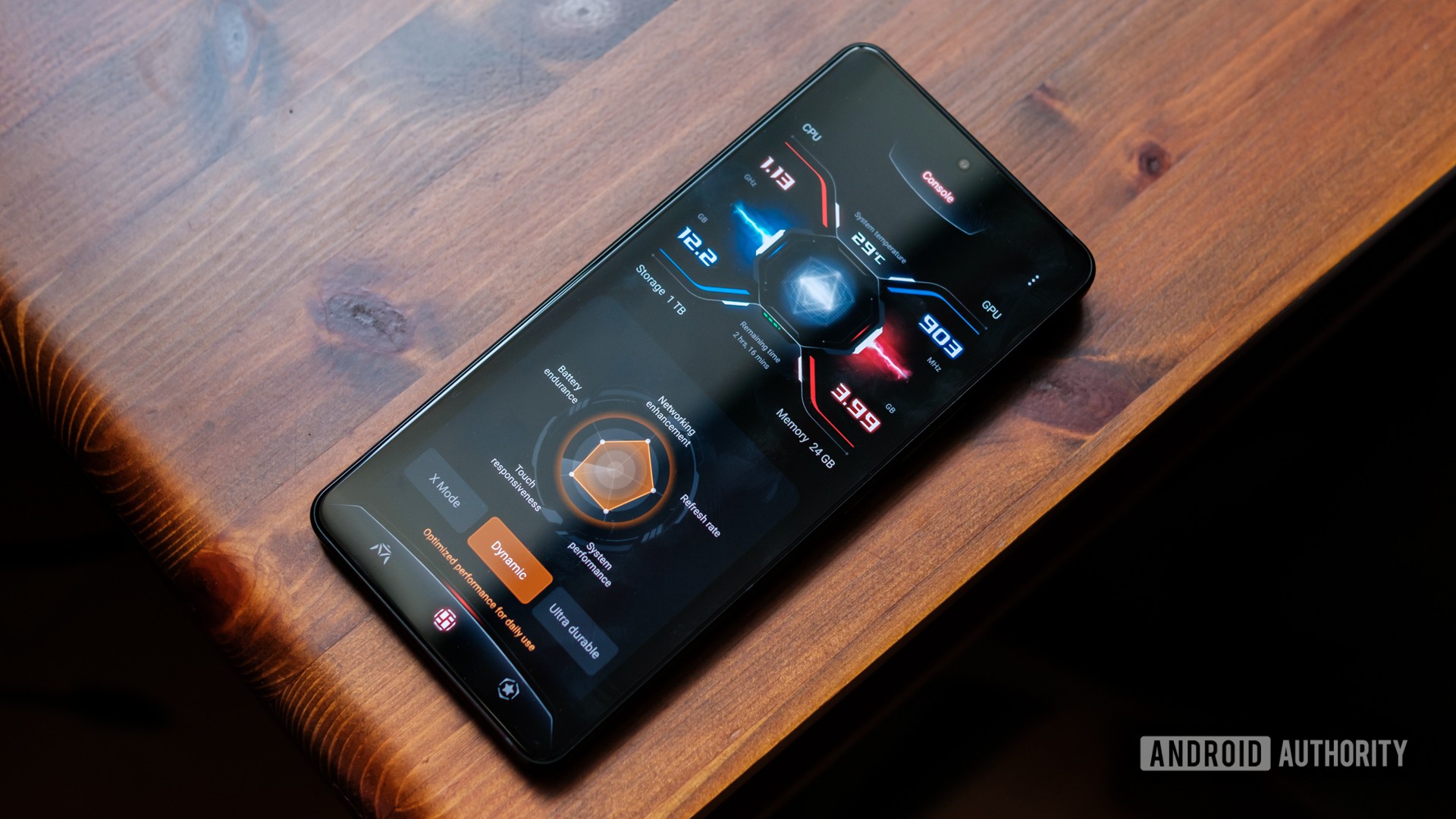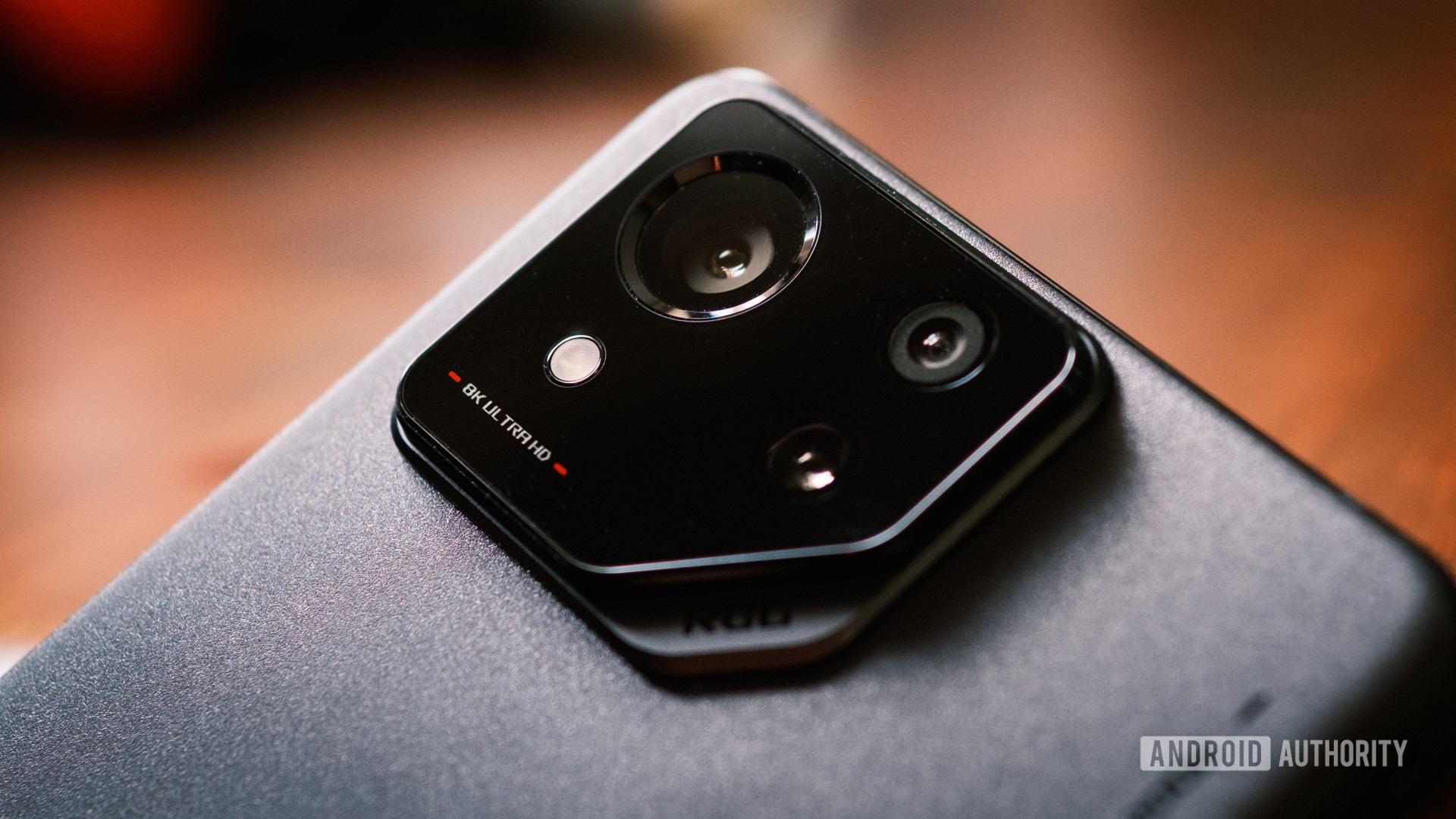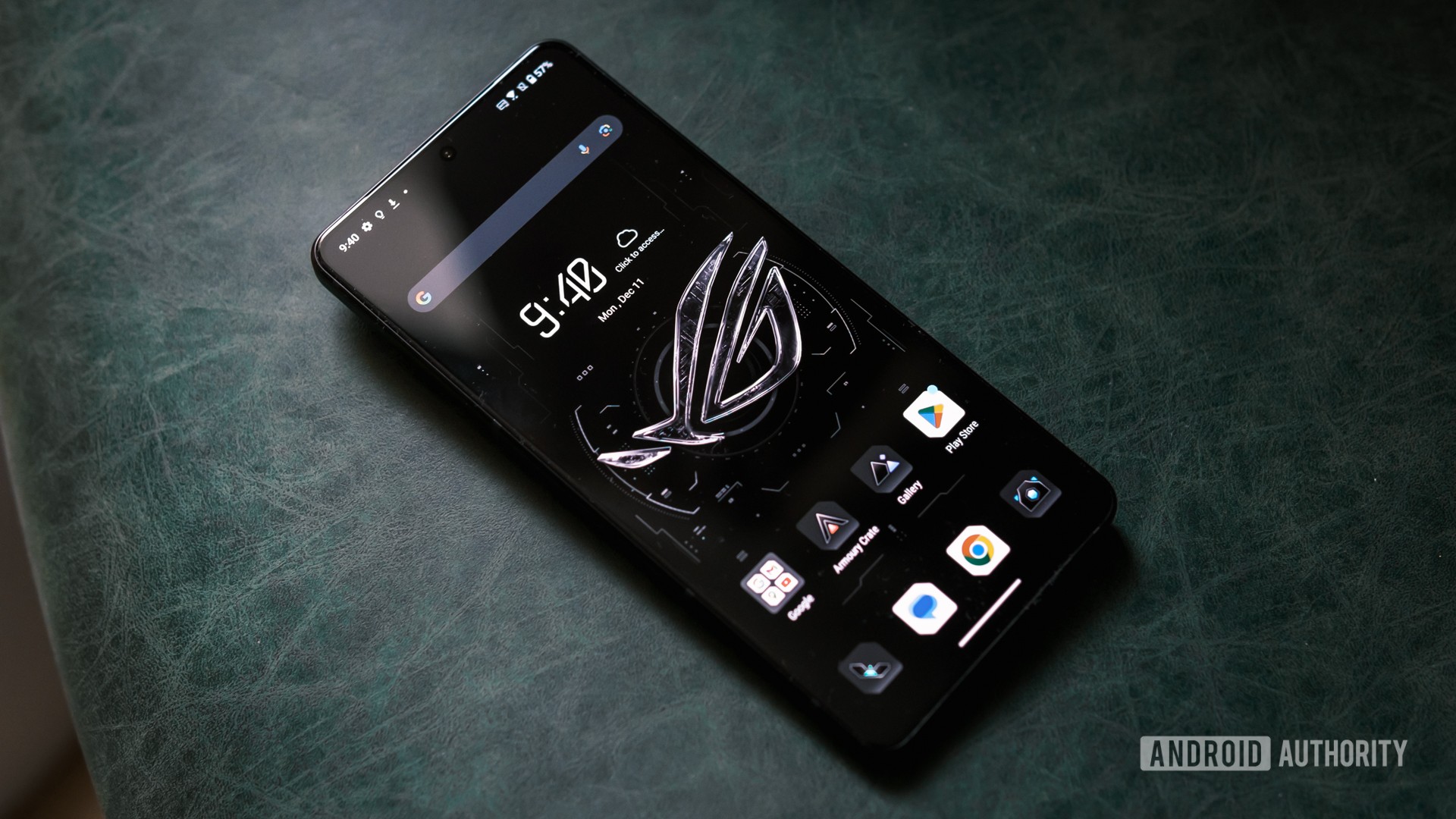Affiliate links on Android Authority may earn us a commission. Learn more.
ASUS ROG Phone 8 hands-on impressions: A classier gaming phone
Published onJanuary 9, 2024
The ASUS ROG Phone 8 Pro series is here, and it’s a big, bold, super-stacked Snapdragon 8 Gen 3 duo of gaming phones for 2024. While I haven’t spent quite long enough to give you a full review of this device, I can say how pleasantly surprised I’ve been with the ROG Phone 8 so far. Here are my early hands-on impressions ahead of Android Authority‘s full review, coming soon.
To start with, ASUS has made some aesthetic changes that make it a sleeker customer than its previous generations. The ROG Phone 8 and 8 Pro have identical footprints, with side-mounted USB-C ports for the cooling module, which comes in the box with the 24GB RAM/1TB storage Pro version, for a limited time with the 16GB/512GB Pro model, or is otherwise sold separately (pricing TBC). This attachment is important for keeping the phone cool if you are gaming for long stretches of time. You can actually charge using both of these USB-C ports, too.
The ROG Phone 8 and 8 Pro do not look like phones tailored specifically for mobile gaming. They remind me slightly of the Sony Xperia line, which is a positive as far as I’m concerned, though some people might like a more obvious gamer-centric aesthetic that stands out from the crowd like we saw with the ROG Phone 7 and previous generations. Elsewhere, there’s a headphone port slapped in here for wired audio, and there is an IP68 rating for the first time on a ROG phone.
In a neat touch, the initial setup includes an interactive game to teach you how to use some of the hardware features, like the returning Air Triggers and the gyro controls. I thought it was fun for all of about a minute, and then I was begging to skip through this section and get the device set up. Luckily, you can skip through it, but it’ll be a fun enough game for people getting used to the controls.

One of the newest features is also called AniMe (not anime!). This is an LED strip at the back of the phone that, in conjunction with software, lights up when you get a notification, has animations when music is playing, and other fancy aesthetic tweaks. Like the ROG Vision window that this feature replaces, you can customize it using the Armory Crate software. It’s definitely gimmicky from the outset, but kind of cool if you want to personalize your phone and add a little bit of gamer flair.

The screen on the ROG Phone 8 looks as good as I’ve seen for a long time; it has some of the deepest, truest blacks on a smartphone so far. It also supports a 165Hz refresh rate, and while I don’t think I can really see a huge step over 120Hz, I haven’t seen a single frame drop anywhere in the UI, so maybe those extra frames and that extra hertz are helping.
ASUS has also kept Android 14 fairly light when it comes to changes. The quick setting toggles use a pre-Android 12 size and layout, which I still like for usability, especially if you want to quickly turn off Bluetooth, Wi-Fi, and other settings. I’d love to see more OEMs revert to this change in the future. Most of the little adjustments in the software, though, are equally well thought out and backed up by some of the best haptics I’ve ever used on a phone. You can customize the vibration style, and I might actually play around with these and tune them even further. But even at default, these are great, especially when using all areas of the OS and those Air Triggers as well, which are backed by haptic feedback.

As for raw specs, the Snapdragon 8 Gen 3 is a fine upgrade on paper. It has speed bumps across all of its cores and a supposed 50% ray tracing performance uplift. If you do want to tweak things like core performance, you can do so using the Armoury Crate settings.
We’ll need to put it through our testing suite to know how well it stacks up against the best Android phones in terms of performance, and the same is true of the camera suite. The latter tends to be one of the weaker areas on a gaming phone, but ASUS has managed to outdo other gaming phones with its cameras in the past, and the ROG Phone 8 series’ setup doesn’t look too bad at a glance. You can check out the full specs below.
ASUS ROG Phone 8 specs
| ASUS ROG Phone 8 | |
|---|---|
Display | 6.78-inch Dynamic AMOLED FHD+ resolution (2,400 x 1,080) 165Hz refresh rate (1-120Hz LTPO) |
Processor | Snapdragon 8 Gen 3 |
RAM | 12GB/16GB/24GB LPDDR5X |
Storage | 256GB/512GB/1TB UFS4.0 No microSD card support |
Power | 5,500mAh battery 65W wired charging 15W wireless charging Charger in box |
Cameras | Rear: - 50MP wide main sensor (f/1.9, 1/1,56-inch sensor, PDAF, 6-axis hybrid gimbal stabilization) - 13MP ultrawide (f/2.2) - 32MP 3x telephoto (f/2.4, 0.7-micron pixel size) Front: - 32MP wide |
Software | ROG UI / Zen UI Android 14 2 Android updates 4 years of security updates |
IP rating | IP68 certified |
Biometrics | In-display fingerprint scanner |
Dimensions | 163.8 x 76.8 x 8.9 mm |
Weight | 225g |
Colors | Black Dark Grey (standard variant only) |
ASUS ROG Phone 8 and ROG Phone 8 Pro first impressions: The next level

While the final verdict will have to wait for our review, it’s clear from just an early look that ASUS is offering a super solid package this year with the ROG Phone 8 series.
ASUS ROG Phone 8: Hot or not?
As for when you can buy one and for how much, ASUS hasn’t revealed a US release date, but has confirmed that pricing will start at $1,099.99 for the base 12GB/256GB model, but with a pre-order price of $999.99. In the UK, the ROG Phone 8 starts at £949.99, while the ROG Phone 8 Pro comes in at £1,099, with pre-orders opening from January 9, 2024.
What do you think of the ROG Phone 8 series? Let us know in the poll and drop any questions you might want us to address in our review in the comments.

